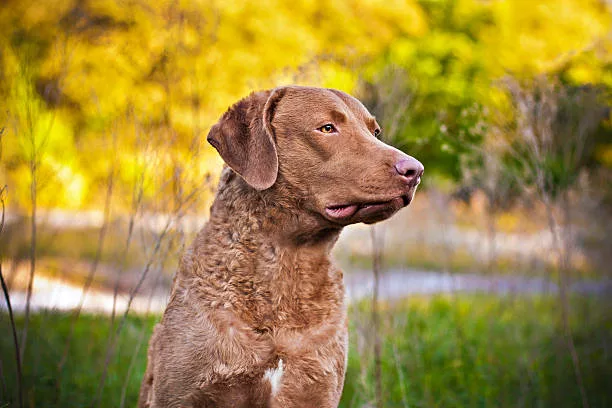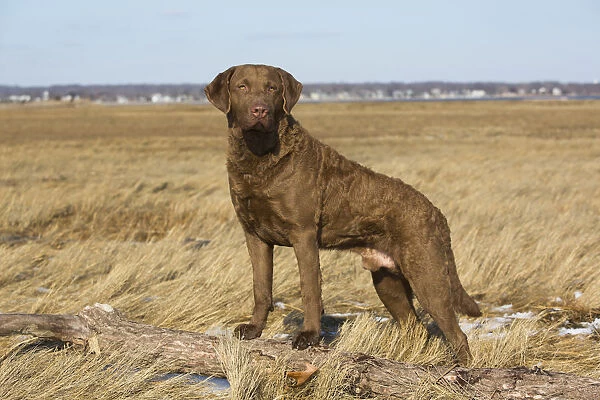The Chesapeake Bay Retriever is a remarkable breed of dog known for its unwavering loyalty, exceptional hunting abilities, and remarkable resilience. Originating from the Chesapeake Bay region of Maryland and Virginia, these dogs have a rich history deeply intertwined with the lives of waterfowlers and sportsmen. Their distinctive dark brown or chocolate coat, muscular build, and determined expression reflect their heritage as rugged working dogs.
Origin and History of the Chesapeake Bay Retriever
The Chesapeake Bay Retriever’s story began in the early 1800s, when waterfowl hunters in the Chesapeake Bay area sought a canine companion capable of retrieving game birds from the icy waters of the bay. Local retrieving dogs were crossed with two Newfoundland pups rescued from a shipwreck in 1807, giving rise to a new breed that embodied the desired traits of strength, endurance, and unwavering determination.

This unique combination of breeding resulted in a dog that was perfectly suited for the harsh conditions of the Chesapeake Bay. They were able to withstand the cold temperatures and strong currents while retrieving waterfowl for their owners. The breed quickly gained popularity among hunters, renowned for their remarkable retrieving skills and ability to withstand the harsh conditions of the bay.
The Legend of Sailor and Canton
One of the most famous stories surrounding the origin of the Chesapeake Bay Retriever involves two dogs named Sailor and Canton. It is said that these two dogs were the first of their kind, born from the crossbreeding of local dogs and the two Newfoundland pups rescued from the shipwreck.
Sailor and Canton were owned by two brothers, John and William Mercer, who were avid waterfowl hunters. These dogs were known for their exceptional retrieving abilities and became highly sought after by other hunters in the area. The brothers were so proud of their dogs that they refused to sell or breed them, leading to the scarcity of the breed at the time.
Physical Characteristics and Distinctive Traits
The Chesapeake Bay Retriever is a medium to large-sized dog, with males standing at 23-26 inches tall and weighing between 65-80 pounds, while females stand at 21-24 inches tall and weigh between 55-70 pounds. They have a muscular build and a strong, athletic appearance, making them well-suited for their original purpose as working dogs.
One of the most distinctive physical traits of the Chesapeake Bay Retriever is their dense, oily coat. This unique coat is often described as “waxy” and provides exceptional insulation against the cold. It also allows them to easily shed water and dry off quickly, making them ideal for retrieving waterfowl in the frigid waters of the Chesapeake Bay.
Coat Colors and Patterns
The Chesapeake Bay Retriever’s coat comes in various shades of brown, ranging from light to dark. The most common color is a deep chocolate brown, but some may have a lighter shade of brown or even a reddish tint. Their coat can also have a slight wave or curl to it, adding to their rugged appearance.
In addition to their solid coat colors, Chesapeake Bay Retrievers may also have small white markings on their chest, toes, or tail. These markings are acceptable according to breed standards and do not affect the dog’s overall appearance or abilities.
Temperament and Personality of the Chesapeake Bay Retriever
The Chesapeake Bay Retriever is known for its unwavering loyalty and devotion to its family. They are intelligent, independent, and have a strong desire to please their owners. However, they also have a stubborn streak and require consistent training and socialization from an early age to prevent any behavioral issues.
These dogs have a strong prey drive and were originally bred for hunting, so they may not do well with small animals or cats. They are also protective of their territory and can be wary of strangers, making them excellent watchdogs.

Energetic and Active
As working dogs, Chesapeake Bay Retrievers have high energy levels and require plenty of physical activity to stay happy and healthy. They excel in outdoor activities such as swimming, retrieving, and agility courses. Without proper exercise, these dogs may become destructive or develop behavioral problems.
It is important to note that this breed is not suitable for apartment living and requires a large, fenced-in yard to run and play. They also make great companions for active individuals or families who enjoy outdoor activities and can provide the necessary exercise for this energetic breed.
Training and Socialization Requirements
The Chesapeake Bay Retriever is an intelligent breed that responds well to positive reinforcement training methods. However, they can be stubborn at times and may require a firm and consistent hand during training. Early socialization is crucial for this breed to prevent any potential aggression towards other animals or strangers.
These dogs thrive on mental stimulation and enjoy learning new tasks and tricks. They are highly trainable and excel in obedience, agility, and tracking competitions. It is important to start training and socialization from a young age to ensure a well-behaved and well-adjusted dog.
Potential Challenges in Training
Due to their independent nature, Chesapeake Bay Retrievers may sometimes challenge their owners’ authority. It is essential to establish yourself as the pack leader and maintain a consistent and structured training routine to prevent any behavioral issues.
They may also have a tendency to become bored with repetitive tasks, so it is important to keep training sessions interesting and varied. Positive reinforcement techniques such as treats, praise, and playtime work best with this breed.
Exercise Needs and Outdoor Activities
As mentioned earlier, Chesapeake Bay Retrievers have high energy levels and require plenty of physical activity to stay happy and healthy. They are natural swimmers and excel in water activities, making them ideal companions for boating or fishing trips. They also enjoy retrieving games and can spend hours playing fetch.
In addition to water activities, these dogs also make great hiking or running partners. They have a strong desire to explore and will happily accompany their owners on outdoor adventures. It is important to note that this breed may not do well in hot weather due to their dense coat, so it is best to plan outdoor activities during cooler times of the day.

Mental Stimulation
Apart from physical exercise, Chesapeake Bay Retrievers also require mental stimulation to prevent boredom and destructive behaviors. Interactive toys, puzzle games, and training sessions can help keep their minds active and engaged. They also enjoy participating in dog sports such as agility, tracking, and dock diving.
Grooming and Care for a Healthy Chesapeake Bay Retriever
The Chesapeake Bay Retriever’s dense, oily coat requires minimal grooming. They have a double coat, with a short, thick undercoat and a longer, harsher outer coat. The undercoat sheds seasonally, while the outer coat remains relatively constant throughout the year.
Weekly brushing is recommended to remove any loose hair and distribute the natural oils throughout the coat. This helps maintain the coat’s waterproofing abilities and keeps it looking shiny and healthy. Bathing should only be done when necessary, as frequent bathing can strip the coat of its natural oils.
Ear and Dental Care
Regular ear cleaning is essential for Chesapeake Bay Retrievers, as their floppy ears can trap moisture and debris, leading to ear infections. It is important to check and clean their ears weekly to prevent any potential issues.
Dental care is also crucial for this breed, as they are prone to dental problems such as tartar buildup and gum disease. Daily brushing and regular dental checkups can help maintain their oral health and prevent any potential issues.
Health Considerations and Common Breed Concerns
Overall, the Chesapeake Bay Retriever is a healthy breed with a life expectancy of 10-12 years. However, like all breeds, they are prone to certain health conditions that owners should be aware of. These include:
- Hip and elbow dysplasia: This is a common condition in large breeds where the hip or elbow joint does not develop properly, leading to pain and mobility issues.
- Progressive retinal atrophy (PRA): This is a degenerative eye disease that can lead to blindness.
- Bloat: This is a life-threatening condition where the stomach fills with gas and twists, cutting off blood supply to vital organs.
- Hypothyroidism: This is a hormonal disorder that affects the thyroid gland, leading to weight gain, lethargy, and skin problems.
It is important to work with a reputable breeder who conducts health screenings on their breeding dogs to reduce the risk of these health conditions in puppies. Regular vet checkups and a nutritious diet can also help keep your Chesapeake Bay Retriever healthy and happy.

Chesapeake Bay Retriever as Working Dogs and Their Roles
The Chesapeake Bay Retriever was originally bred as a working dog, specifically for retrieving waterfowl in the Chesapeake Bay. They have a strong prey drive and an excellent sense of smell, making them ideal hunting companions. Apart from their retrieving abilities, they are also used for tracking, flushing, and pointing game birds.
These dogs are also used in search and rescue operations, as their strong swimming abilities and endurance make them well-suited for water rescues. They have also been trained as therapy dogs, providing comfort and support to those in need.
The Chesapeake Bay Retriever in Competitive Events
Chesapeake Bay Retrievers excel in various competitive events, showcasing their intelligence, athleticism, and trainability. They are often seen competing in obedience, agility, tracking, and dock diving competitions. Their natural abilities and desire to please their owners make them top contenders in these events.
Chesapeake Bay Retrievers as Family Companions and Their Suitability
While the Chesapeake Bay Retriever may have a strong working background, they also make excellent family companions. They are loyal, affectionate, and protective of their loved ones. However, due to their high energy levels and strong prey drive, they may not do well with small children or other pets.
These dogs require an active and dedicated owner who can provide them with plenty of exercise and mental stimulation. They also thrive on human companionship and do not do well when left alone for long periods. With proper training and socialization, they can make loving and devoted family pets.
Finding a Chesapeake Bay Retriever Breeder and Responsible Ownership
If you are interested in adding a Chesapeake Bay Retriever to your family, it is important to find a reputable breeder who prioritizes the health and well-being of their dogs. A responsible breeder will conduct health screenings on their breeding dogs and provide proper care and socialization for their puppies.
It is also essential to understand the commitment and responsibility that comes with owning a Chesapeake Bay Retriever. These dogs require plenty of exercise, grooming, and training to thrive. They also have a strong desire to please their owners and need consistent and positive reinforcement training methods.
Video
Conclusion
In conclusion, the Chesapeake Bay Retriever is a remarkable breed with a fascinating history deeply rooted in the Chesapeake Bay region. Their distinctive physical traits and unwavering loyalty make them stand out among other breeds. While they may have a strong working background, they also make loving and devoted family companions with the right owner.
If you are considering adding a Chesapeake Bay Retriever to your family, it is important to do thorough research and understand the breed’s needs and characteristics. With proper care, training, and socialization, these dogs can bring joy and companionship to their owners for many years to come.